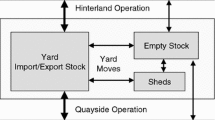Abstract
In this paper, we introduce an integer linear program for planning the layout of container yards. We concentrate on a special layout class of container yards which we call yard layout with transfer lanes. For those layouts typically rubber tired gantry cranes are used for stacking operations and trucks for horizontal transports. We show that the optimization model can be formulated as a special type of a resource constrained shortest path problem for which the LP relaxation always has at least one integer optimal solution. This model is restricted to a rectangular storage yard which allows a linear formulation. For an arbitrary shaped container yard we adopt the model and develop a variable neighborhood descent (VND) heuristic for solving non-rectangular instances. Concerning the rectangular case, we show that the VND heuristic achieves optimal solutions for 38% of the realistic test instances.
Similar content being viewed by others
References
Ahuja RK, Magnanti TL, Orlin JB (1993) Network flows: theory, algorithms, and applications. Prentice Hall, Englewood Cliffs
Beasley JE, Christofides N (1989) An algorithm for the resource constrained shortest path problem. Networks 19: 379–394
Dekker R, Voogd P, van Asperen E (2006) Advanced methods for container stacking. OR Spectr 28(4): 563–586
Drira A, Pierreval H, Hajri-Gabouj S (2007) Facility layout problems: A survey. Annu Rev Control 31(2): 255–267
Duinkerken M, Dekker R, Kurstjens S, Ottjes J, Dellaert N (2006) Comparing transportation systems for inter-terminal transport at the maasvlakte container terminals. OR Spectr 28(4): 469–493
Handler GY, Zang I (1980) A dual algorithm for the constrained shortest path problem. Networks 10(4): 293–309
Hansen P, Mladenovic N (2001) Variable neighborhood search: Principles and applications. Eur J Oper Res 130(3): 449–467
Imai A, Sasaki K, Nishimura E, Papadimitriou S (2006) Multi-objective simultaneous stowage and load planning for a container ship with container rehandle in yard stacks. Eur J Oper Res 171(2): 373–389
Irnich S, Desaulniers G (2005) Shortest path problems with resource constraints. In: Column generation. Springer, Berlin, pp 33–65
Kim KH (1997) Evaluation of the number of rehandles in container yards. Comput Ind Eng 32(4): 701–711
Kim KH, Kim HB (1999) Segregating space allocation models for container inventories in port container terminals. Int J Prod Econ 59: 415–423
Kim KH, Park Y-M, Jin M-J (2008) An optimal layout of container yards. OR Spectr 30(4): 675–695
Liu C, Jula H, Vukadinovic K, and Ioannou P (2000) Comparing different technologies for containers movement in marine container terminals. In: IEEE intelligent transportation systems conference proceedings
Liu C-I, Jula H, Ioannou P (2002) Design, simulation, and evaluation of automated container terminals. IEEE Trans Intell Trans Syst 3: 12–26
Liu C-I, Jula H, Vukadinovic K, Ioannou P (2004) Automated guided vehicle system for two container yard layouts. Transpo Res C 12: 349–368
Mladenovic N, Hansen P (1997) Variable neighborhood search. Comput Oper Res 24(11): 1097–1100
MOPS (2009) Mops—mathematical optimization system: About mops. MOPS Optimierungssysteme GmbH and Co. KG. http://www.mops-optimizer.com. Accessed 08 Mar 2009
Petering MEH (2009) Effect of block width and storage yard layout on marine container terminal performance. Transp Res E Logist Transp Rev 45: 591–610
Petering MEH, Murty KG (2009) Effect of block length and yard crane deployment systems on overall performance at a seaport container transshipment terminal. Comput Oper Res 36(5): 1711–1725
Saanen YA, Valkengoed MV (2005) Comparison of three automated stacking alternatives by means of simulation. In: WSC ’05: Proceedings of the 37th conference on winter simulation, pp 1567–1576. Winter simulation conference
Singh S, Sharma R (2006) A review of different approaches to the facility layout problems. Int J Adv Manuf Technol 30(5): 425–433
Stahlbock R, Voß S (2008) Operations research at container terminals: a literature update. OR Spectr 30(1): 1–52
Steenken D, Voß S, Stahlbock R (2004) Container terminal operation and operations research—a classification and literature review. OR Spectrum 26: 3–49
Suhl UH (1994) Mops—mathematical optimization system. Eur J Oper Res 72(2): 312–322
UNCTAD (2008) Review of Maritime Transport 2008. UNCTAD.
Vis IFA (2006) A comparative analysis of storage and retrieval equipment at a container terminal. Int J Prod Econ 103(2): 680–693
Vis IFA, de Koster R (2003) Transshipment of containers at a container terminal: An overview. Eur J Oper Res 147(1): 1–16
Vis IFA, Harika I (2004) Comparison of vehicle types at an automated container terminal. OR Spectr 26(1): 117–143
Wiese J, Kliewer N, Suhl L (2009) A survey of container terminal characteristics and equipment types. Technical Report 0901, DS&OR Lab, University of Paderborn. http://dsor.upb.de/uploads/tx_dsorpublications/DSOR_WP_0901.pdf
Wiese J, Suhl L, Kliewer N (2010) Mathematical programming and simulation based layout planning of container terminals. Manuscript. Int J Simul Process Modell (to appear)
Yang C, Choi Y, Ha T (2004) Simulation-based performance evaluation of transport vehicles at automated container terminals. OR Spectr 26(2): 149–170
Author information
Authors and Affiliations
Corresponding author
Rights and permissions
About this article
Cite this article
Wiese, J., Suhl, L. & Kliewer, N. Mathematical models and solution methods for optimal container terminal yard layouts. OR Spectrum 32, 427–452 (2010). https://doi.org/10.1007/s00291-010-0203-6
Published:
Issue Date:
DOI: https://doi.org/10.1007/s00291-010-0203-6




